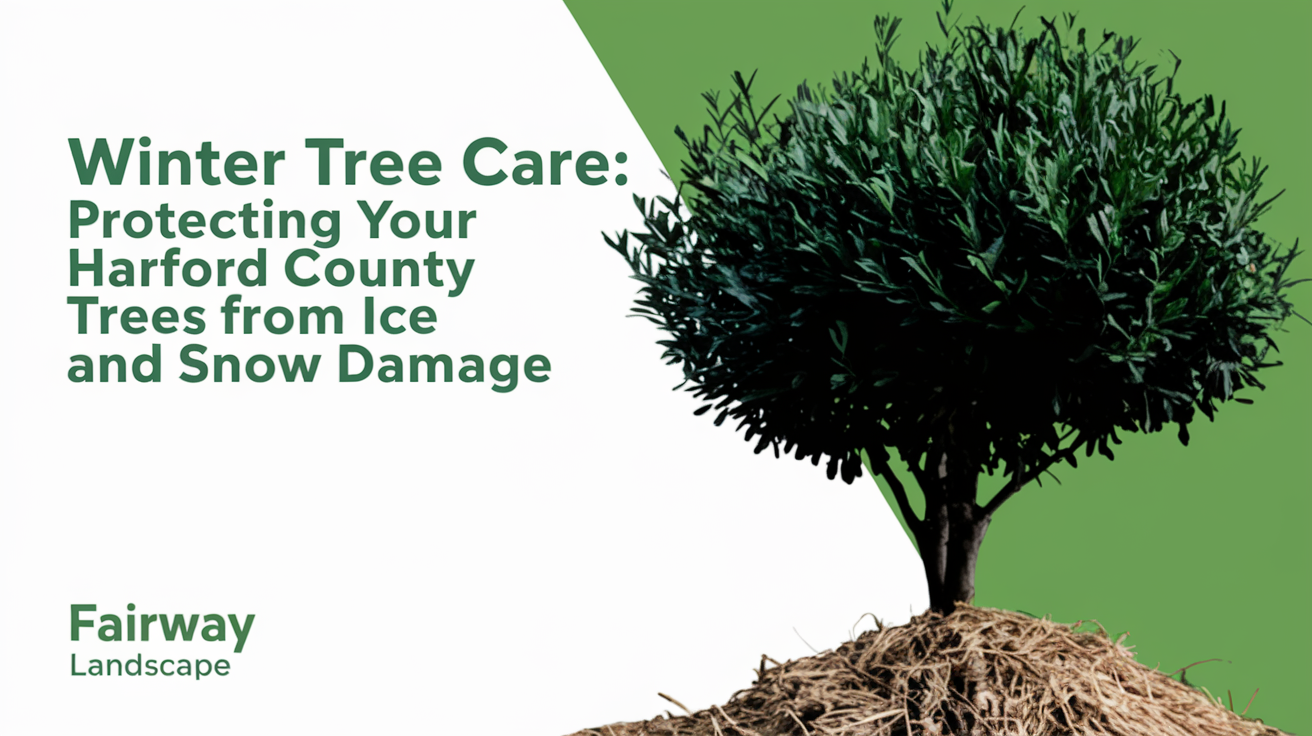The weather forecasters are predicting our first significant winter storm of the season to arrive in Harford County next week. While snow-covered landscapes create picturesque winter scenes, the weight of ice and snow can cause devastating damage to valuable trees and shrubs. Broken limbs, split trunks, and even complete tree failures not only destroy landscape investments but create significant safety hazards around your home. Proactive winter tree care can dramatically reduce these risks while preserving your property’s beauty and value.

Understanding How Winter Storms Damage Trees
Ice accumulation creates extraordinary weight on branches. Just one-quarter inch of ice can add 500 pounds of weight to power lines—imagine what it does to your tree branches. This sudden loading exceeds the structural capacity of many limbs, particularly those with existing defects or poor attachment angles. Our Harford County arborist services include structural assessment that identifies vulnerable branches before they fail.
Snow loading affects trees differently depending on form and species. Evergreens with their dense foliage catch and hold more snow than deciduous trees, while trees with horizontal branch structures accumulate more snow than those with more upright growth habits. Understanding these species-specific vulnerabilities allows targeted protection strategies for your particular landscape trees.
Wind compounds ice and snow damage significantly. Winter storms often combine precipitation with strong winds, creating dynamic loading that stresses trees from multiple directions. This combination frequently causes more extensive damage than either factor alone. Professional winter tree maintenance includes evaluation of wind exposure and appropriate preventative measures for vulnerable specimens.
Preventative Pruning: Your First Line of Defense
Structural pruning reduces winter damage risk significantly. Professional pruning that removes crossing branches, corrects poor attachment angles, and thins excessive end weight creates trees better equipped to withstand winter loading. This specialized pruning requires understanding of both tree biology and structural engineering principles—expertise our certified arborists bring to every property.
Deadwood removal eliminates high-risk branches. Dead branches are significantly more brittle than living wood and typically the first to fail under ice or snow loading. Our comprehensive winter tree protection services include thorough deadwood removal, particularly over structures, driveways, and walkways where falling branches present safety hazards.
Crown thinning allows snow and ice to pass through rather than accumulate. Selective removal of interior branches reduces surface area for ice accumulation while preserving the tree’s natural form. This specialized technique requires professional judgment to remove enough material for meaningful load reduction without compromising tree health or structural integrity.
Cabling and Bracing for Vulnerable Trees
Support system installation protects valuable mature trees. For specimen trees with structural concerns, professional cabling and bracing provides supplemental support during winter loading events. These systems distribute weight more effectively and prevent catastrophic failures of important branches or co-dominant stems. Our arborists evaluate candidates for support systems and install industry-standard hardware designed for decades of protection.
Inspection of existing support systems ensures continued protection. If your trees already have cables or bracing rods, professional inspection before winter storms is essential. Hardware components can deteriorate over time, and growing trees may require adjustments to maintain effective support. Our winter tree maintenance includes thorough evaluation of existing support systems and necessary updates or replacements.
Risk assessment identifies priority candidates for support. Not every tree warrants the investment in cabling or bracing. Our professional evaluation considers the tree’s structural condition, location relative to targets, species characteristics, and overall health to determine appropriate candidates for these specialized treatments. This targeted approach provides protection where it matters most.
Emergency Preparation for Winter Storms
Response planning should happen before storms arrive. Knowing who to call when trees are damaged, understanding your insurance coverage for tree damage, and having basic emergency supplies ready can significantly reduce stress when winter storms impact your property. Our clients receive priority response during weather emergencies—valuable assurance when damaged trees threaten structures or access.
Documentation of pre-storm conditions proves valuable for insurance claims. Professional assessment with photographic documentation establishes baseline conditions before winter weather arrives. This documentation often proves invaluable when filing insurance claims for storm-damaged trees and property. Our comprehensive evaluations provide this important record.
Equipment readiness ensures prompt response when damage occurs. Professional tree care companies maintain specialized equipment for winter storm response—from aerial lifts that access damaged canopies to specialized rigging systems that safely remove hanging branches. Our year-round investment in state-of-the-art equipment means we’re prepared when winter emergencies strike.
Protecting Young and Recently Planted Trees
Staking systems require professional installation and monitoring. While staking can protect young trees from winter storms, improper staking often causes more harm than good. Our professional approach includes appropriate staking methods that provide stability without restricting necessary trunk movement or causing bark damage. Equally important, we remove or adjust staking systems as trees establish to prevent long-term problems.
Anti-desiccant applications protect evergreens from winter burn. Winter winds and sun exposure can dry out evergreen foliage while frozen soil prevents water uptake—a condition called winter burn. Professional application of anti-desiccant products creates a protective coating that reduces moisture loss during vulnerable winter months. This protection is particularly important for recently planted specimens and exposed sites.
Trunk protection prevents multiple winter hazards. Young trees with thin bark are vulnerable to sunscald, frost cracking, and rodent damage during winter months. Professional installation of trunk wraps or guards addresses these concerns while avoiding common problems like moisture trapping and insect harborage that improper materials can create.
Post-Storm Tree Care and Recovery
Damage assessment requires professional expertise. After winter storms, distinguishing between trees that can be saved and those that require removal takes considerable experience. Our certified arborists evaluate damaged trees using industry-standard risk assessment protocols, identifying salvageable specimens while recommending removal when necessary for safety.
Proper pruning of storm-damaged trees influences long-term recovery. Correct pruning cuts minimize decay entry while establishing appropriate structure for future growth. Improper cutting often compounds storm damage and creates long-term health problems. Our recovery pruning follows arboricultural best practices that maximize healing potential.
Soil management supports root recovery after winter stress. Heavy snow loads and frozen soil conditions can damage root systems, particularly for recently planted trees. Our comprehensive recovery programs include soil assessment and appropriate amendments that support root regeneration when growing conditions return.
Year-Round Care for Winter-Resilient Trees
Soil health management creates storm-resistant trees. Trees growing in optimal soil conditions develop more extensive root systems and stronger wood—both critical factors in winter storm resilience. Our comprehensive soil management programs include appropriate amendments, mulching, and root zone aeration that build long-term tree health and structural strength.
Proper irrigation during growing seasons develops stronger trees. Both drought stress and excessive moisture can compromise wood strength and root development. Our professional irrigation management ensures trees receive appropriate moisture throughout the growing season, developing the structural integrity needed to withstand winter challenges.
Integrated pest management prevents weakening by insects and diseases. Trees compromised by pests or pathogens have reduced capacity to withstand winter stresses. Our year-round monitoring and targeted intervention prevents these biological stressors from compromising your trees’ structural integrity before winter storms arrive.
Partner with Fairway Landscape for Complete Tree Protection
At Fairway Landscape, we offer comprehensive winter tree care services throughout Harford County. Our certified arborists understand the unique challenges our regional climate presents and implement proven strategies to protect your valuable trees. From preventative pruning and structural support to emergency response and recovery care, our complete service packages ensure your landscape remains safe and beautiful despite winter’s challenges.
Contact us today to schedule your professional winter tree assessment. Our experienced arborists will evaluate your property’s specific vulnerabilities and develop a customized protection plan that addresses your landscape’s unique needs. Don’t wait until ice and snow damage your valuable trees – partner with Fairway Landscape for professional protection that preserves your landscape investment.

